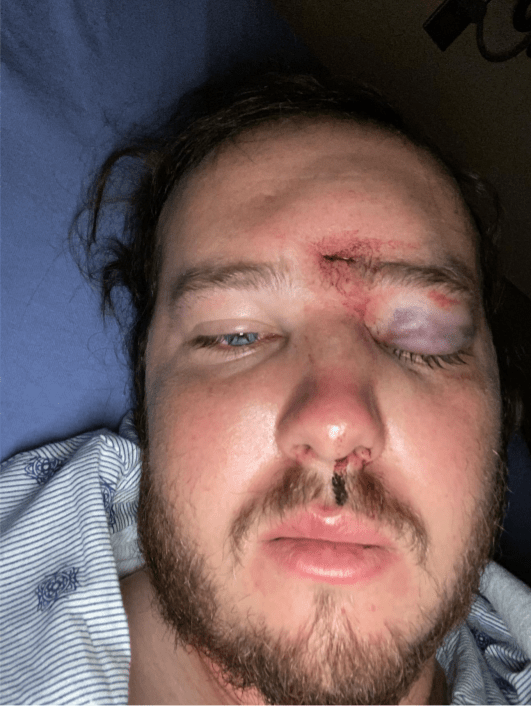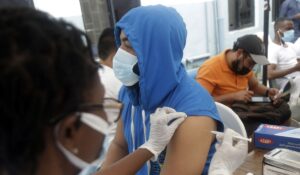Courtesy Michael Driscoll
Michael Driscoll filed a federal lawsuit on Monday against Denver alleging one of the city’s officers used excessive force when they shot him in the face with a projectile. The projectile fractured his skull in two places and Driscoll required surgery.
Michael Driscoll was filming protests in downtown Denver last year when a police projectile slammed into his forehead, shattered his sinus and fractured his skull in two places.
The injury required skull reconstruction surgery that left him with 53 staples across his head, according to a federal lawsuit Driscoll filed Monday against Denver, police Chief Paul Pazen and police Cmdr. Patrick Phelan.
Driscoll, a welder, had to take a month off work to recover and will likely not be able to pursue a career as an underwater welder as planned because his skull might not be able to withstand the pressure of diving, said Milo Schwab, Driscoll’s attorney.
The lawsuit alleges the unidentified officer who shot him used excessive force and that the department and its leaders should be held liable because they did not properly train or supervise the officer.
“(Driscoll) could’ve died,” Schwab said. “If they had struck him two inches higher on his forehead, the risk of death was very high.”
The lawsuit adds to the growing collection of at least six suits — representing more than 60 plaintiffs — filed against the city alleging Denver police officers used excessive force and injured peaceful protesters in May and June of 2020. The department’s response to the protests has been widely criticized and an investigation into the department’s response by the city’s watchdog agency found it was flawed at nearly every level. The department opened 123 internal investigations into officers’ conduct, but few officers will be disciplined.
Driscoll drove up from Pueblo on May 30, 2020, to join the massive protests of police brutality and George Floyd’s murder by a Minneapolis police officer. After a day of protesting, he decided to continue demonstrating the following day.
Driscoll’s video footage of the incident shows a crowd of protesters demonstrating about 10 p.m. May 31, 2020, at the intersection of West 13th Avenue and Cherokee Street near Denver police headquarters. The protesters chanted “I can’t breathe” and “Hands up, don’t shoot” toward a line of police officers dozens of yards away. The video does not show the group of protesters marching toward the officers or throwing anything at them. People in the crowd can be heard in the video urging others to remain peaceful.
Without an audible warning or command to disperse, the officers began to launch gas containers and other projectiles toward the crowd, the video shows. Driscoll’s video shows him raising a piece of wood, which the lawsuit stated was a homemade shield he made to protect himself. The plywood shield had “ACAB” painted on it, an acronym that stands for “all cops are bastards.”
A projectile then struck Driscoll, who can be heard groaning in the video. Other people in the crowd can be heard in the video shouting “He’s bleeding!” and “Who’s a medic!” as they walked with Driscoll away from the intersection.

Courtesy of Milo Schwab
Surgeons had to use 53 staples to close Michael Driscoll’s skull after it was fractured by a projectile fired by an unknown police officer during a May 31, 2020, protest of police brutality, according to a lawsuit filed Monday by Driscoll.
A stranger drove Driscoll to Denver Health, where a doctor found two skull fractures that shattered his sinus, the lawsuit states. Driscoll underwent surgery three days later. Surgeons had to use a graft from a different part of his skull to repair the damage, according to the lawsuit.
Driscoll continues to suffer pain and headaches from the injury, Schwab said. He also has large medical bills from his hospitalization and surgery.
Schwab said his client is not exactly sure what kind of projectile police shot at him but believes it was likely a foam or rubber round.
Denver police used 40 mm foam rounds during the protests. According to department policy, officers are only to use the less-lethal weapon against someone who is aggressive toward them or to prevent serious injury. The 40 mm launchers used by Denver police fire their projectiles at more than 200 mph, according to the Office of the Independent Monitor, which conducted an investigation into how Denver police responded to the 2020 racial justice protests.
“Impact can cause bruising, swelling, lacerations, critical eye injuries and skull fractures,” the watchdog agency’s investigation states.
The Denver Police Department and the Denver City Attorney’s Office declined to comment on the lawsuit.
In addition to monetary damages, Driscoll’s lawsuit asks a judge to ban Denver police from using chemical weapons on protesters and from firing less-lethal projectiles indiscriminately into a demonstration. The lawsuit also asks a judge to require Denver police officers to issue a dispersal warning and give a chance for protesters to leave.
Police at the Denver protests struck at least 15 people in the head with less-lethal munitions or tear gas canisters, Schwab said. At least two people lost eyes after they were injured.
“We need structural change and a reflection by police of what they did,” Schwab said.



















